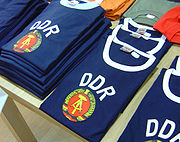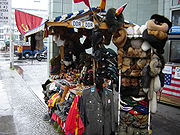
Ostalgie
Encyclopedia


German language
German is a West Germanic language, related to and classified alongside English and Dutch. With an estimated 90 – 98 million native speakers, German is one of the world's major languages and is the most widely-spoken first language in the European Union....
term referring to nostalgia
Nostalgia
The term nostalgia describes a yearning for the past, often in idealized form.The word is a learned formation of a Greek compound, consisting of , meaning "returning home", a Homeric word, and , meaning "pain, ache"...
for aspects of life in East Germany. It is derived from the German words Ost (east) and Nostalgie (nostalgia).
The term Ostalgie (along with the phrase Soviet chic
Chic (style)
Chic , meaning 'stylish' or 'smart', is an element of fashion.-Etymology:Chic is a French word, established in English since at least the 1870s...
) is also occasionally used to refer to nostalgia for life under the socialist system in other former communist countries of Eastern Europe
Eastern Europe
Eastern Europe is the eastern part of Europe. The term has widely disparate geopolitical, geographical, cultural and socioeconomic readings, which makes it highly context-dependent and even volatile, and there are "almost as many definitions of Eastern Europe as there are scholars of the region"...
, most notably Poland
Poland
Poland , officially the Republic of Poland , is a country in Central Europe bordered by Germany to the west; the Czech Republic and Slovakia to the south; Ukraine, Belarus and Lithuania to the east; and the Baltic Sea and Kaliningrad Oblast, a Russian exclave, to the north...
and the Soviet Union
Soviet Union
The Soviet Union , officially the Union of Soviet Socialist Republics , was a constitutionally socialist state that existed in Eurasia between 1922 and 1991....
.
History
After the fall of the Berlin wallBerlin Wall
The Berlin Wall was a barrier constructed by the German Democratic Republic starting on 13 August 1961, that completely cut off West Berlin from surrounding East Germany and from East Berlin...
in 1989 and the German reunification
German reunification
German reunification was the process in 1990 in which the German Democratic Republic joined the Federal Republic of Germany , and when Berlin reunited into a single city, as provided by its then Grundgesetz constitution Article 23. The start of this process is commonly referred by Germans as die...
that followed a year later, many of the symbols of the German Democratic Republic were swept away. Almost all GDR brands of products disappeared from the stores and were replaced by Western products. However, with the passing of time some East Germans began to feel nostalgia for certain aspects of their lives in East Germany. Ostalgie particularly refers to the nostalgia for aspects of regular daily life and culture in the former GDR, which disappeared after reunification.
Manifestations
Many businesses in GermanyGermany
Germany , officially the Federal Republic of Germany , is a federal parliamentary republic in Europe. The country consists of 16 states while the capital and largest city is Berlin. Germany covers an area of 357,021 km2 and has a largely temperate seasonal climate...
cater to those who feel Ostalgie and have begun providing them with artifacts that remind them of life under the GDR; artifacts that imitate the old ones. Now available are formerly defunct brands of East German foodstuffs, old state television programmes on video
Video
Video is the technology of electronically capturing, recording, processing, storing, transmitting, and reconstructing a sequence of still images representing scenes in motion.- History :...
and DVD
DVD
A DVD is an optical disc storage media format, invented and developed by Philips, Sony, Toshiba, and Panasonic in 1995. DVDs offer higher storage capacity than Compact Discs while having the same dimensions....
, and the previously widespread Wartburg and Trabant
Trabant
The Trabant is a car that was produced by former East German auto maker VEB Sachsenring Automobilwerke Zwickau in Zwickau, Sachsen. It was the most common vehicle in East Germany, and was also exported to countries both inside and outside the communist bloc...
cars. In addition, life in the GDR has been the subject of several recent films, including Leander Haußmann
Leander Haußmann
Leander Haußmann is a German theatre and film director.The son of actor Ezard Haußmann and costume designer Doris Haußmann, he attended the Ernst Busch theatre school in Berlin....
's Sonnenallee
Sonnenallee
Sonnenallee is a 1999 comedy film about life in East Berlin in the late 1970s. The movie was directed by Leander Haußmann. The film was released shortly before the corresponding novel, Am kürzeren Ende der Sonnenallee...
(1999), Wolfgang Becker
Wolfgang Becker
Wolfgang Becker is a German film director and writer. He is best known to the international audience for his work Good Bye Lenin! .-Biography:...
's internationally successful Good Bye Lenin!
Good Bye Lenin!
Good Bye, Lenin! is a 2003 German tragicomedy film, released internationally in 2003. Directed by Wolfgang Becker, the cast includes Daniel Brühl, Katrin Saß, Chulpan Khamatova, and Maria Simon...
(2003), and Carsten Fiebeler's Kleinruppin forever
Kleinruppin forever
Kleinruppin forever is a German romantic comedy film, released in late-2004.The film is set in 1985 and stars Tobias Schenke as Tim Winter, a West German teenager from Bremen with aspirations of being a professional tennis player. On a school trip to East Germany, Tim meets his identical twin...
(2004).
Those seeking the preservation of East German culture banded together to save Ossie Crosswalk Man (Ost-Ampelmännchen
Ampelmännchen
is the symbolic person shown on traffic lights at pedestrian crossings in the former German Democratic Republic . Prior to the German reunification in 1990, the two German states had different forms for the Ampelmännchen, with a generic human figure in West Germany, and a generally male figure...
), an illuminated depiction of a fedora wearing man in crosswalk lights. Many German cities in and near the former East German border, including Berlin
Berlin
Berlin is the capital city of Germany and is one of the 16 states of Germany. With a population of 3.45 million people, Berlin is Germany's largest city. It is the second most populous city proper and the seventh most populous urban area in the European Union...
, Lübeck
Lübeck
The Hanseatic City of Lübeck is the second-largest city in Schleswig-Holstein, in northern Germany, and one of the major ports of Germany. It was for several centuries the "capital" of the Hanseatic League and, because of its Brick Gothic architectural heritage, is listed by UNESCO as a World...
and Erfurt
Erfurt
Erfurt is the capital city of Thuringia and the main city nearest to the geographical centre of Germany, located 100 km SW of Leipzig, 150 km N of Nuremberg and 180 km SE of Hannover. Erfurt Airport can be reached by plane via Munich. It lies in the southern part of the Thuringian...
, still retain the use of the Ampelmännchen at all or some pedestrian crossings due to its cultural relevance, and many souvenirs sold in East Germany and in Berlin (at Checkpoint Charlie) make use of the icon.
See also
- OstrockOstrockOstrock is rock music from the formerly communist East Germany. The word derives from the German word "ost" , and "rock" .-Notable ostrock bands:* City* Feeling B* Gerhard Gundermann* Nina Hagen* Karat* Keimzeit* Lift...
- Die anderen BandsDie anderen BandsDie anderen Bands is a term combining alternative music bands of 1980s GDR . They shared a more or less open criticism of their country's political system, and a high degree of creativity which was lacking from the more established music scene of East Germany. Many members of these bands played...
- Culture of the German Democratic RepublicCulture of the German Democratic RepublicThe Culture of East Germany varied throughout the years due to the political and historical events that took place in the 20th century, especially as a result of Nazism and Communism. A reflection on the history of arts and culture in East Germany reveals complex relationships between artists and...
- Vita-ColaVita-ColaVita Cola is a cola beverage produced in Germany. It started out in the German Democratic Republic. Introduced in 1957, it was advertised as Brauselimonade mit Frucht- und Kräutergeschmack , using a formula that is still kept secret...
: an example of a product revived by Ostalgie - AmpelmännchenAmpelmännchenis the symbolic person shown on traffic lights at pedestrian crossings in the former German Democratic Republic . Prior to the German reunification in 1990, the two German states had different forms for the Ampelmännchen, with a generic human figure in West Germany, and a generally male figure...
: the waiting/walking man used in East German pedestrian traffic lights, which became a distinctive mascotMascotThe term mascot – defined as a term for any person, animal, or object thought to bring luck – colloquially includes anything used to represent a group with a common public identity, such as a school, professional sports team, society, military unit, or brand name...
for the Ostalgie movement - TrabantTrabantThe Trabant is a car that was produced by former East German auto maker VEB Sachsenring Automobilwerke Zwickau in Zwickau, Sachsen. It was the most common vehicle in East Germany, and was also exported to countries both inside and outside the communist bloc...
: East German automobile produced until 1991; for some, an icon of East Germany. - Yugo-nostalgiaYugo-nostalgiaYugo-nostalgia is a little-studied psychological and cultural phenomenon occurring among citizens of the former Socialist Federal Republic of Yugoslavia...
: a similar phenomenon in the former Yugoslavia - The Legend of RitaThe Legend of RitaThe Legend of Rita is a 2000 German film about fictionalised exiled West German radical left Red Army Faction members, though the fictional characters all have close parallels to several real-life RAF members...
: Film precursor of Ostalgie - Good Bye Lenin!: A satirical film involving a post-reunification deception.
- SonnenalleeSonnenalleeSonnenallee is a 1999 comedy film about life in East Berlin in the late 1970s. The movie was directed by Leander Haußmann. The film was released shortly before the corresponding novel, Am kürzeren Ende der Sonnenallee...
: Film that has been accused of "glorifying" the GDR - The Lives of OthersThe Lives of OthersThe Lives of Others is a 2006 German drama film, marking the feature film debut of filmmaker Florian Henckel von Donnersmarck. The film involves the monitoring of the cultural scene of East Berlin by agents of the Stasi, the GDR's secret police...
: Film that could be seen as a counterpoint to Ostalgie
Books
- Banchelli, Eva: Taste the East: Linguaggi e forme dell'Ostalgie, Sestante Edizioni, Bergamo 2006, ISBN 88-87445-92-3.
- Banchelli, Eva: Ostalgie: eine vorläufige Bilanz, in Fabrizio Cambi (Hg.): Gedächtnis und Identitat. Die deutsche Literatur der Wiedervereinigung, Würzburg, Koenigshausen & Neumann, 2008, pp. 57–68.
- Berdahl, Daphne: On the Social Life of Postsocialism: Memory, Consumption, Germany (2009)
- Rota, Andrea: Testi pubblicitari ostalgici: una breve analisi semiotica, in «Linguistica e Filologia» 24/2007, p. 137–152.
External links
- "Ostalgie", post from The New York TimesThe New York TimesThe New York Times is an American daily newspaper founded and continuously published in New York City since 1851. The New York Times has won 106 Pulitzer Prizes, the most of any news organization...
- "Germans miss the 'good old days' of the GDR ", France 24France 24France 24 is an international news and current affairs television channel. The service is aimed at the overseas market, similar to BBC World News, DW-TV, NHK World and RT, and broadcast through satellite and cable operators throughout the world. During 2010 the channel started broadcasting through...
, October 3, 2008 - Criticism of historical transfiguration, Englis summary
- "Ostalgie" discussion on H-German

